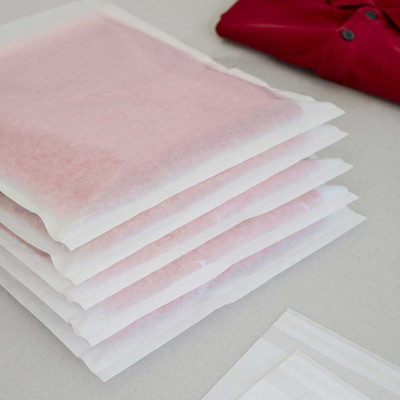What is Glassine?
Posted By on Sep 30th 2024
by Saloni Doshi • published September 30, 2024 • 7 min read
Have you ever encountered smooth, glossy paper that magically resists air, water, and grease? That’s glassine.
In this article, we'll explore what makes glassine unique and why it's becoming a solid choice for brands going plastic-free.
What is Glassine?
Glassine is a smooth, glossy, translucent paper with dust protection and water and grease resistance. It is made from wood pulp and goes through a supercalendering process to make it perfect for protecting documents, photos, and products and keeping food fresher without moisture damage.
You likely encounter glassine often in your daily life. Here are some common examples:
- Glassine merchandise bags
- Bakery and snack bags
- Merchandising
- Archival paper
- Tracing paper
- Art protection sheets or bags
- Product and apparel protection
How is Glassine Made?
First, it’s important to be clear that glassine is paper. There are no coatings or additives to glassine. Understanding the unique manufacturing process of glassine paper helps explain how it gets its distinctive properties.
Manufacturing Process
Glassine is produced through a unique process called supercalendering, which involves the following steps:
-
Pulping
Wood is chipped and cooked to break down the lignin bonds, allowing the cellulose fibers to be separated. Complete lignin removal is essential for glassine.
-
Sheet Formation
The pulp slurry is bleached and treated, then spread onto a moving wire cloth where water drains out. The fibers mat together, forming paper sheets.
-
Pressing and Drying
These sheets are pressed to remove excess water and dried. This step is standard for most paper production.
-
Supercalendering
Glassine undergoes an additional step; the dried sheets are repeatedly passed through heated or cooled pressurized rollers (supercalenders).
This process aligns the fibers in one direction, increasing the paper's density, reducing porosity, and giving it a glossy finish.
The supercalendering process transforms the paper at a cellular level. It breaks down the capillaries of the fibers and gives glassine its unique properties.
What are the Uses of Glassine?

Glassine is a versatile material used in various industries and by individuals due to its unique properties. Here are some typical applications:
Food Packaging
Glassine is frequently used in the food industry for wrapping baked goods, candies, and snacks. Its moisture and grease resistance helps keep food fresh without additional coatings.
Art Protection
Artists and collectors use glassine to protect artwork, photos, and prints. Its smooth, non-abrasive surface prevents smudging and damage, and it is often acid-free with pH ranging from 7-9, making it ideal for archival purposes.
Retail Packaging
In retail, glassine bags are used for packaging clothing, stationery, and small gifts. Its translucent quality allows for an attractive presentation while protecting the items inside.
Wholesale Packaging
In a wholesale supply chain, glassine bags can be a great plastic-free alternative that protects apparel and other goods from factory to end consumer.
Industrial Packaging
Glassine protects metal parts from rust in industrial uses. It is also used as interleaving paper in making technical films.
Gifting and Decorative Packaging
Glassine is perfect for wrapping homemade treats, organizing crafts, and storing delicate items like stamps and photos. Its protective qualities ensure your items remain in good condition, and its smooth, translucent finish makes it ideal for presentation.
These uses show that glassine effectively protects products in various settings, from homes to industries.
How is Glassine Different from Standard Paper?
Glassine vs Standard Paper
- Moisture and Grease Resistance: Glassine provides higher resistance to moisture and grease than standard paper, which tends to absorb water and is affected by humidity. Glassine is not, however, waterproof, It may better withstand droplets of water and ambient humidity. But, it is still paper and will not withstand submersion into water.
- Durability and Strength: Glassine is nearly twice as dense as standard paper, making it more resistant to tearing and puncturing.
- Smooth Texture: Glassine has a smooth, non-abrasive surface (often called “toothless”), ideal for handling delicate items without causing damage. Standard paper is rougher and can be abrasive.
- No Shedding: Glassine’s glossy surface prevents shedding, keeping your products clean, whereas standard paper can shed tiny fibers.
- Translucency: Glassine is naturally translucent, allowing a partial view of the contents. Standard paper is typically opaque.
- Static-Free: Glassine does not generate static, while standard paper can.
Glassine vs. Other Specialty Papers
When assessing eco-friendly packaging options, it’s essential to understand the differences between glassine and its alternatives: vellum bags, parchment paper, wax paper, and cellophane.
Glassine vs Parchment Paper
Technically, the term parchment refers to a material made from the skin of animals, typically sheep, goats, or calves, that has been treated, stretched, and dried to create a durable writing surface. Parchment was historically used for writing manuscripts, documents, and legal texts before the widespread use of paper. Making parchment involves removing hair, soaking the skin in a lime solution, and then stretching it on a frame before scraping it to achieve the desired thinness and smoothness.
When people use the word “parchment paper” today, they typically refer to a wood pulp-based paper that is treated and coated to be non-stick and heat-resistant. This modern parchment paper is used primarily in cooking and baking to line pans or trays, preventing food from sticking and making clean-up easier. The term "parchment" in this context refers to its similarity in appearance and texture to the traditional parchment made from animal skin, but the two are entirely different in composition and use.
Today’s parchment paper tends to be made by supercalendaring paper and then treating it with silicone to make it heat-resistant and oven safe.
Parchment paper differs from glassine in that it is treated with silicone and often rendered unrecyclable.
Glassine vs Vellum
Traditionally, vellum is a type of high-quality parchment usually made from calfskin, lambskin, or kidskin. It has been used for centuries as a durable and smooth writing surface, particularly for important documents, illuminated manuscripts, and legal texts. Vellum is known for its fine texture and longevity, making it a popular choice for archival purposes and high-end printing, though modern versions are also made from treated plant fibers or synthetic materials.
Today, vellum is a term used to describe fine paper in general. The term does not necessarily represent a specific material. Sometimes, vellum is made with wood pulp (basically, glassine). Often, it refers to a paper made with cotton pulp or other high-quality, non-wood fibers.
Glassine vs Wax Paper
Wax paper is a type of paper that has been coated with a thin layer of wax, typically paraffin or soybean-based. This wax coating makes the paper moisture-resistant and non-stick, which gives it various practical applications in the kitchen and beyond. Unlike parchment paper, wax paper is not heat resistant.
Glassine has no coating, making it more readily recyclable than wax paper and other coated papers.
The Eco-Friendly Benefits of Glassine
Glassine can help brands cut their use of clear poly bags and can be an eco-friendlier alternative to other non-curbside recyclable materials.
Recyclable Glassine Bags
Glassine bags can be recycled curbside. Thin film plastic (such as clear poly bags made with LDPE) can only be recycled in source-separated drop-off bins. Wax and plastic-coated papers need special recycling.
Biodegradable and Compostable Glassine Bags
Because glassine bags are paper with no coatings, they are also naturally biodegradable. They can be home-composted and industrially composted in facilities that accept packaging.
FSC® Certified Glassine Bags
Unfortunately, glassine is almost always made with virgin paper due to the fiber length required to produce this unique material. One significant risk of sourcing virgin paper is that it could risk ancient and endangered forests. EcoEnclose’s glassine bag offerings are FSC® Certified, minimizing this risk and reducing the negative impacts of traditional logging.
Environmental Challenges of Glassine
There are a few environmental downsides to glassine:
- Virgin paper: Glassine is almost always made with virgin paper due to the long fiber length required to produce the unique material. For various reasons, recycled content is always preferred, particularly regarding paper, whose raw materials pose a risk to our primary forests.
- Carbon footprint: Because of the high heat required to produce glassine, it is more carbon-intensive than traditional paper. When compared to thin film, glassine has a significantly higher carbon footprint (even more so than the gap between clear poly film and standard paper).
- Resource consumption: Paper, particularly glassine paper, consumes water and energy at a significantly higher rate than the clear film the material is often replacing.
Awareness of glassine’s environmental downsides is essential, as it helps brands more thoughtfully navigate the decision-making process when evaluating glassine versus standard paper versus poly film.
Eco-Friendly Glassine Options
Products such as Vela Glassine Bags showcase the versatility of glassine in the eCommerce space. These bags are a unique plastic-free alternative to clear poly bags that have become ubiquitous in the apparel supply chain.
Explore our eco-friendly packaging solutions to learn more.
FAQs
1. Is glassine better than plastic?
Like all paper, glassine is curbside recyclable, naturally biodegradable, and compostable. From an end-of-life perspective, it is superior to plastic.
However, plastic can be made with recycled content and is a carbon-efficient material. On the other hand, glassine is always made with virgin content, requires fairly high resources to produce, and has relatively high carbon emissions.
Neither material is perfect. However, with many brands prioritizing curbside recyclability and plastic-free these days, glassine is an appealing, sustainable packaging alternative to plastic.
2. Is glassine the same as parchment paper?
No, glassine and parchment paper are not the same. Glassine is a smooth and glossy paper made through supercalendering, making it resistant to air and water. On the other hand, parchment paper is coated with silicone to make it non-stick and heat-resistant, often used in baking.
3. Can water be packed in glassine?
While glassine provides some resistance to moisture and grease, it is not waterproof. It is not suitable for holding liquids like water and will not withstand being submerged in water.
4. Is glassine eco-friendly?
Glassine is considered an eco-friendly alternative to plastic because it is made from renewable wood pulp, is curbside recyclable, naturally biodegradable, and compostable.
However, it does have its downsides. Specifically, it is made from virgin content and has a higher carbon and resource footprint than the mainstream packaging it often replaces.
We strongly recommend that brands understand the entire life cycle of the materials they are considering to make eco-conscious packaging decisions that best support their specific environmental goals.
5. What are the disadvantages of glassine paper?
Disadvantages of glassine paper:
- Less durable than synthetic materials
- Prone to tears and punctures
- Often more expensive than plastic
- Made with virgin content
- Requires high heat and energy to produce
6. Is glassine paper strong?
Glassine paper is strong for a paper product. It resists grease, moisture, and air. But, it is not as durable as many plastics. It cannot handle heavy items or harsh environments as well.
READ MORE
About EcoEnclose
EcoEnclose is the leading sustainable packaging company that provides eco-packaging solutions to the world’s most forward-thinking brands.
We develop diverse, sustainable packaging solutions that meet our rigorous research-based standards and customers’ goals. We drive innovative packaging materials to market and consistently improve the circularity of existing solutions.
Is the Vela Bag Right for Your Brand?
Explore how the Vela Bag—our curbside recyclable, FSC® certified glassine alternative to plastic poly bags—is helping brands of all sizes transition to plastic-free packaging with confidence, scalability, and supply chain ease.


